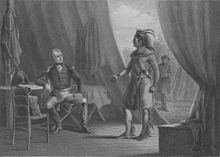
Back حرب الكريك Arabic Guerra Creek Catalan Guerra Creek (1813-1814) Spanish جنگ نهر Persian Creek-sota Finnish Guerre Creek French Guerra creek Italian クリーク戦争 Japanese 크리크 전쟁 Korean Creekkrigen NB
This article includes a list of references, related reading, or external links, but its sources remain unclear because it lacks inline citations. (October 2023) |
| Creek War | |||||||||
|---|---|---|---|---|---|---|---|---|---|
| Part of the War of 1812 and the American Indian Wars | |||||||||
 William Weatherford surrendering to Andrew Jackson | |||||||||
| |||||||||
| Belligerents | |||||||||
|
Muscogee Cherokee Choctaw |
Red Sticks Tecumseh's confederacy | ||||||||
| Commanders and leaders | |||||||||
|
Andrew Jackson John Floyd Ferdinand Claiborne John Coffee William McIntosh Pushmataha Mushulatubbee |
William Weatherford Menawa Peter McQueen | ||||||||
| Strength | |||||||||
| ~7,000 | ~4,000 | ||||||||
| Casualties and losses | |||||||||
| ~584 killed | ~1,597 killed | ||||||||
The Creek War (also the Red Stick War; the Creek Civil War), was a regional conflict between opposing Native American factions, European powers, and the United States during the early 19th century. The Creek War began as a conflict within the tribes of the Muscogee, but the United States quickly became involved. British traders and Spanish colonial officials in Florida supplied the Red Sticks with weapons and equipment due to their shared interest in preventing the expansion of the United States into regions under their control.
The Creek War took place largely in modern-day Alabama and along the Gulf Coast. Major engagements of the war involved the United States military and the Red Sticks (or Upper Creeks), a Muscogee tribal faction who resisted U.S. colonial expansion. The United States formed an alliance with the traditional enemies of the Muscogee, the Choctaw and Cherokee Nations, as well as the Lower Creeks faction of the Muscogee. During the hostilities, the Red Sticks allied themselves to the British. A Red Stick force aided British Naval Officer Alexander Cochrane's advance towards New Orleans. The Creek War effectively ended in August 1814 with the signing of the Treaty of Fort Jackson, when Andrew Jackson forced the Creek confederacy to surrender more than 21 million acres in what is now southern Georgia and central Alabama.[1]
According to historian John K. Mahon, the Creek War "...was as much a civil war among Creeks as between red and white..."[2] The war was also a continuation of Tecumseh's War in the Old Northwest, and, although a conflict framed within the centuries-long American Indian Wars, it is usually more identified with, and considered an integral part of, the War of 1812 by historians.[according to whom?]
- ^ Green (1998), Politics of Removal, p. 43
- ^ Mahon, John K., The History of the Second Seminole War, 1835–1842 (1967), University of Florida Press. p. 22